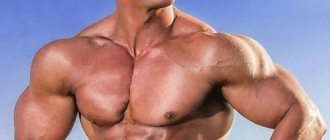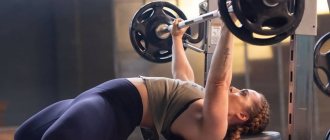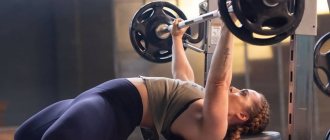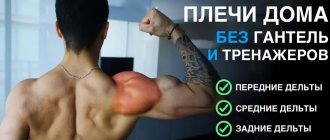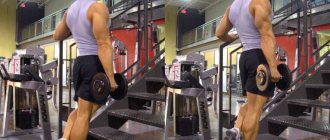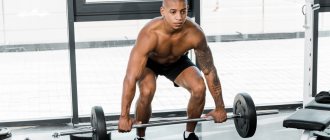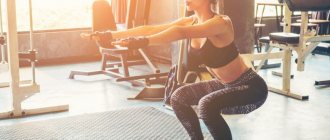Author of the article
Andrey Belozertsev
Drawing up programs for effective muscle mass gain.
Building broad, muscular shoulders is every man’s dream.
After all, sculpted and voluminous hands emphasize masculinity and strength like nothing else.
There are many sets of shoulder training - all muscles at the same time or each separately.
In this article you will learn how to properly pump up your shoulders in the gym.
Training for mass and width
With increased muscle mass gain, you need to take relatively heavy equipment and reduce the number of repetitions (within reason, of course).
After the warm-up, you need to start training with the base - barbell and dumbbell bench presses.
The next stage will be to work on each beam of deltas. This will be discussed in detail in the following sections.
You can pump up your deltoids in width only through regular training - at least twice a week.
You need to increase the complexity of the exercises gradually, first adding more difficult elements, and only when the new exercises are brought to automaticity, you can move on to equipment of greater mass.
As you complete the elements in one workout, it is necessary to gradually reduce the weight of the equipment so as not to cause shock to the body.
So, when performing the last approaches with a barbell, you should reduce the number of plates by a total of five kilograms.
Program
Below are the main exercises that will bring the greatest effect when training for muscle mass.
Approximate program for weight and width:
- Dumbbell press in a sitting position, arms above your head - 4 sets, each approach needs to increase the number of repetitions by two - 4, 6, 8 and 10 times.
- Barbell rows to the chin – 3 sets of 8, 9 and 10 times.
- Dumbbell lateral raises – 4 sets of 12, 14 and 16 repetitions.
- Dumbbell lateral raises - 3 sets of 10, 12 and 14 repetitions.
- Lifting the barbell overhead - 3 sets: 6, 8, 10 lifts.
Basic exercises will be described in the following sections.
Previously, we told you how to remove your butt.
Is it worth doing both in one day?
Despite the widespread belief that training your back and shoulders in one day is not only pointless, but also dangerous, modern research in the field of strength training indicates the opposite.
Qualified specialists with sufficient knowledge in the field of physiology and sports unanimously claim that complex exercises of this kind can significantly speed up the process of pumping the athlete’s upper body.
The correct construction of such a training scheme implies:
- correct alternation of loads (exercises for the back should be chosen traditional, and for the shoulders, within one lesson, it is advisable to give static and dynamic loads alternately);
- mandatory warm-up and cool-down (before and after training, respectively);
- gradual increase in working weight;
- competently determined frequency of sports, combining pumping of the muscles of the back and shoulders.
Important! You should not start training with the use of heavy weights, even if you are in good physical condition. Gradually increasing the load can prevent injuries that have a direct impact on the overall health of the athlete
Terrain training
As with most relief exercises, you need to do it with light weights - a lot and at a fast pace.
Such loads not only pump up muscles, but also burn fat at the same time, which allows you to more clearly “draw” each muscle.
However, when training for deltoids, there are nuances: you need to perform several supersets with a large mass so that each muscle bundle is worked out.
Otherwise, no amount of drying can help - the shoulders will simply resemble a solid round ball, unnaturally attached to the bones.
It is necessary to alternate long-term loads with light weights and short periods of weight lifting so that a “cut” is observed - the separation of each muscle from the total as a result of pumping all sections of the delta.
In another article we told you how to remove your belly and sides.
Program
Relief training includes a variety of exercises.
Here are just the main ones:
- Arnold Seated Press – 4 sets of 10 reps.
- Dumbbell lateral raises – 3 sets of 20 reps.
- Bent-over dumbbell raises – 3 sets of 20 reps.
- Lifting the barbell to the chin - 3 sets of 10 times.
- Exercise on a special “butterfly” simulator for the rear delts – 3 sets of 15 times.
- Raising arms to the sides with an expander – 3 sets of 15-18 times.
The butterfly exercise machine is a rather rare piece of equipment, so it is not available in all gyms.
If it is absent, you can perform additional sets of lifting the barbell to the chin.
See also: How to remove thighs.
Training for quick results
Every beginner is interested in the question of how long it takes to pump up your shoulders. It will take at least three months.
Fast pumping involves simultaneous load on all three deltas, so the workout contains relatively few elements.
In this case, you can quickly get your shoulders into shape, but you should not expect the appearance of an impressive relief or large mass.
Program for quick results
Most often, the express pumping scheme includes basic simple exercises that do not require a certain level of skill to perform.
This program includes:
- Exercise on the “butterfly” simulator – 3 sets of 12-15 reps.
- Dumbbell overhead press – 3 sets of 12 reps.
- Standing dumbbell lateral raises – 3 sets of 12-15 reps.
The technique for performing these exercises will be described in detail in the sections devoted to pumping each section of the deltoid muscle.
What is the deltoid muscle
The deltoid muscle is a brachialis muscle that covers the shoulder joint. It consists of three bundles:
- Front No. 1 is responsible for raising the arm forward. Always involved in training the chest muscles (especially when performing incline bench presses and dips);
- Middle No. 2 is responsible for raising the arm to the side. The width and massiveness of the shoulder muscle depends on it; it is necessary to focus on working it out;
- Back number 3 is responsible for moving the arm back. Involved in training the back muscles (especially in various deadlifts). “Pumping up” it is the most difficult thing, so most athletes simply avoid it and score the “bolt”, but in vain...
How to pump up deltoids
A set of exercises for the front deltoids
The front delts are indirectly involved when performing exercises on the chest muscles, so they are developed better than the rest of the shoulder.
This must be taken into account when planning classes: the break between training for the front deltoids and chest should be at least two days.
Seated overhead press
You can quickly pump up your shoulders in the gym and at home using dumbbell presses.
The exercise is performed with dumbbells weighing at least eight kilograms. It can be performed at home or in the gym.
The press must be done step by step:
- Sit on a bench or exercise machine with a backrest. The body should be level, the head should not be tilted forward or thrown back. The dumbbells should be held with a straight grip, elbows bent so that the dumbbells are in line with the ears.
- As you exhale, you need to lift your hands up, pushing out the dumbbells. After a pause of a few seconds, you need to smoothly return down.
It is better to pump up in four approaches of 15-18 times.
Arnold press
Arnold Schwarzenegger's favorite exercise has become a classic for subsequent generations of bodybuilders. It allows you to pump up powerful deltoids.
Technique:
- Sitting on a bench, the body is straight, pressed against the back of the sports furniture. Feet stand at a distance of twice the width of your hips from each other, dumbbells are at chin level, elbows are bent. The palms “look” at us.
- As you exhale, you should lift the projectiles and halfway through the “path”, turn the sours with your palms away from you. Stay at the top point for 2-3 seconds and return to the starting position.
The more approaches, the better the muscles are pumped up: the ideal option is 4 sets of 15 repetitions.
A set of exercises for the middle deltoids
Bench Press
Building up your shoulders with a barbell is very easy if you follow the correct technique.
This exercise is extremely effective, but can lead to injury if you don't hold the barbell. Therefore, it is recommended to perform it with a partner.
The technique is simple and looks like this:
- Sitting on a horizontal surface, your legs can be positioned arbitrarily. The bar should be held with a straight grip behind the neck below the back of the head.
- As you exhale, you need to forcefully push the projectile upward, straightening your elbows. As you exhale, slowly lower the barbell.
Do 2-3 sets of 10-12 reps.
Lifting the barbell to the chin
If we list all the ways to pump up our shoulders, lifting the barbell to the chin is the best.
This exercise is considered basic for fully working out the middle deltoids.
You need to follow the steps below:
- Stand up straight, squeezing your shoulder blades together and relaxing your shoulders. The bar should be held with a straight grip on straightened limbs below in front of you.
- As you exhale, lift the barbell, bending your elbows and spreading them to the sides. You need to stay in this position for at least three seconds and smoothly lower the projectile while inhaling.
Do 2-3 sets of 15 lifts.
Standing Dumbbell Lateral Raise
This exercise also effectively pumps the posterior deltoid muscles. Thanks to it, you can make your shoulders broad and massive at the same time.
You can pump up your deltoids with dumbbells this way:
- You need to stand straight with your feet shoulder-width apart. The body is aligned, arms with dumbbells are lowered down to the sides.
- As you exhale, you should, without sudden movements, lift the projectiles to shoulder level across the sides. Hold with straight arms perpendicular to the floor.
- As you inhale, lower the dumbbells.
You cannot lift the dumbbell above the level of the collarbones so that the load is not redirected to the pectoralis major muscle and does not leave the shoulder region.
Perform a minimum of 2-3 sets of 20 repetitions.
A set of exercises for the rear deltoids
Bent-over lateral raise
This exercise is the best option for targeted pumping of the rear delts.
It is not always accessible to beginners, since the load is distributed to the weaker posterior bundles, which are little involved in everyday life and during classic shoulder training complexes.
Technique:
- Standing, feet shoulder-width apart, back straight. The body is tilted forward at an angle of 50-60°, the legs are slightly bent at the knees. Dumbbells should be held with a neutral grip.
- Raise the exercises to shoulder level as you exhale, hold for 2-3 seconds and lower your hands as you inhale.
The minimum you need to do is 3-4 sets of 12-15 times.
To increase the load, you can perform this exercise while sitting on a bench. You can also swing dumbbells while bent over.
Reclining on a bench
The load is distributed across all delta bundles, but the rear sections work especially well. This exercise will help you build up massive, round shoulders.
You need to do the following:
- Take a reclining position on a bench, leaning one elbow behind your back. Feet are placed on the floor hip-width apart. Dumbbells must be held with a straight grip.
- As you exhale, you need to raise your straightened arm until it becomes parallel to the floor. The projectile should be at head level.
- Slowly return to the starting position while inhaling.
The more repetitions, the better. The ideal option is 80 times, divided into several sets.
On the butterfly simulator
This exercise machine is specifically designed to pump up the rear deltas, which are responsible for the width of the shoulders.
Also, when performing this complex, the back is well worked out. In this case, you need to visit the gym twice a week.
Stages and technique:
- You need to sit on the machine, having previously installed the upper levers at shoulder width. Hold the handles with a neutral grip. Your arms should be straight at the elbows in front of you and parallel to the floor.
- Lifting the load is carried out while inhaling by spreading the arms; you should move the limbs back as far as possible. At the extreme point, you need to pause for 2-3 seconds so that your shoulders receive maximum load.
- As you exhale, return to the starting position.
Do 2-3 sets of 18-20 repetitions.
Summary
To summarize, we can say that for the development of not only the shoulders, but also all muscles, several conditions must be met:
- Training should not be daily; muscles should not only work, but also recover. Therefore, do not ignore rest days, train 3-4 times a week. Two days off from training are mandatory;
- Loads must be selected correctly, taking into account the individuality of the body. Beginners should not start tearing muscles with heavy weights right away. It definitely won’t get better, but injuries are very difficult to recover;
- Each requires its own degree of load, but there is a rule for everyone - when working on weight, do not perform the approach more than 12 times. This is how the body works, discoveries in the field of physiology have long proven this. By training your muscles more than 15 times, the endurance mode turns on, here you will, on the contrary, begin to lose volume, but see the relief. And for this you must first gain muscle;
- Don't skip meals, you need to eat 5-6 times a day. In this case, the diet must contain all the necessary nutrients: proteins - from 2 g per 1 kg of weight, carbohydrates - from 3 g per 1 kg of weight, fats - 1-2 g. For weight gain, the distribution of dietary fat during the day does not play a role, therefore combine foods with any calorie content in the morning and before bed. Breakfast is the main meal of the day, and the meal at night is no less important. And hunger is the main enemy, it provokes muscle burning;
- Sports nutrition will be an indispensable assistant in nutrition, both for loading in the morning, after training and before bed. You can take protein or essential amino acids after sleep to help prevent the catabolic effect. Full cycle amino acids can be taken before training. And at night you need a slow protein, for example casein, or a gainer, which can also replace meals after exercise.
Do not forget about the correct technique, consult an experienced trainer, let him observe your training and give advice if necessary. Keep a food diary, write down your diet and count calories. Record the working weight, gradually increase it, and change exercises. All the rules will quickly become a habit, and you will definitely see progress.
Similar articles
- Shoulder exercises in the gym are the best...
Read more - Shoulder exercises with your own weight without axial...
Read more
- Video of our shoulder workouts - advanced version
Read more
- Back and shoulders training in one day * Program…
Read more
- Legs and shoulders training in one day * Program…
Read more
3 18
Did you like the article? Share with friends:
We recommend reading:
Exercises for shoulder and neck pain – “gymnastics 911” for treating shoulder injuries!
Exercises for the posterior delta of the shoulder: a set of exercises in the gym and at home
Training legs and shoulders in one day - a split for a beginner?
Exercises to relax the muscles of the neck and shoulders
How to pump up your shoulders on the horizontal bar and parallel bars - TOP workout exercises
Discussion: 3 comments
- QuadroVik says:
There is no need to train the front deltoid like that. It is better to do two exercises for the back than one each for the front and back. You can’t have enough bench presses in your program, but you always struggle with rows, which is why the back one lags behind. And visually the mass is created by the middle beam; it is enough for him to do bench presses while standing or sitting and stretching - Andr0id says:
The front bun has never swayed and it is the most developed for me. I feel it most when bench pressing at an angle. The rear one always lagged behind, and when the back began to sag under its weight and the shoulders rounded, I began to pay maximum attention to it. The program on the site is cool, but I would remove the front one and put 1-2 exercises on the middle and 2-3 on the back. For anyone who has problems with posture, this is just the thing.
- Number1 says:
As a coach with 9 years of experience, I advise you to completely exclude the military press. Even if you bench press 40 kg, the load on your back is heavy, who needs problems with the spine later? Do bench presses only while sitting!!! Eliminate your back, and your shoulders will work better. The article is good but there are a couple of contradictions and controversial points. But it's good for beginners.
Training intensity and frequency
Training should last at least an hour. It is best to plan several complexes for 80-90 minutes.
In order for the muscles to have time to recover, it is necessary to exercise no more than three times a week with breaks of two days.
The intensity depends on the desired result, initial physical fitness and health status.
Before your first visit to the gym, you should undergo a full medical examination to confirm the absence of diseases.
When performing relief training, the number of repetitions should increase by approximately 20-30% compared to the mass gain complex.
To increase shoulder width, you should pay special attention to the rear deltoids. You need to start with two sets of fifteen movements.
If the exercise is difficult - three sets of ten times. Gradually, the number of approaches must be increased, as well as repetitions per set.
However, the number of repetitions is not unlimited: if you have exceeded the threshold of four sets of twenty-five times, you should take a projectile of greater mass.
If your shoulders don't grow
Shoulders are the most “capricious” part of the body, pumping which is difficult even for advanced and amateurs.
If you do not follow the technique, the load will shift to the biceps or chest, and the entire set of exercises will be meaningless.
The main mistakes that beginners make:
- The load is placed on the wrong groups of bundles and muscles in general. As a rule, the anterior and middle sections do most of the work, while the rear “rests” much more often. That is why it is important to comprehensively pump all parts of the shoulders.
- The first three to four months of training should be devoted to basic training and only then move on to pumping each beam separately.
- It is equally important to pump up your arms and chest first, so that shoulder exercises can be performed with a normal weight, and not from a “zero level”.
- It is necessary to be able to correctly select the mass of shells. A sign of correctly selected weight of the projectile is that 12-15 repetitions can be done without noticeable load, the rest is already accompanied by fatigue and unpleasant sensations in the muscles.
- It is necessary to gradually increase the load - the number of sets and weight, so that the shoulders increase mass, and do not remain “in the same place”.
- The shoulders are a muscle whose contraction should be felt during the execution of the element. If you don't see this, there's a good chance you're doing something wrong.
In order for muscles to grow quickly, you need to switch to a low-carbohydrate diet: about 55% of the diet should be protein, 25% carbohydrates and 20% fat.
From fats you need to eat sour cream, from carbohydrates - porridge, vegetables, whole grain bread.
The best natural sources of proteins: meat, fish, dairy products, eggs, nuts. If such food is not enough, you can purchase special protein sports nutrition.
It is equally important to drink a lot of water a day if you play sports - at least two and a half liters.
Can sports nutrition become a growth booster?
With high physical activity, not only does muscle fatigue occur, but there is also a large load on the nervous system. Namely, for high-quality growth, not only a heavy load is necessary, but also proper restoration of muscles and all systems. In this case, an important condition is nutrition - replenishment of all nutrients from food. But to restore the body of an active athlete, much more calories and nutrients are required. Then sports nutrition becomes an indispensable assistant, which saturates the athlete’s body with all nutrients in sufficient quantities, is quickly absorbed and contains rich nutritional value in comparison with conventional food products.
Sometimes eating porridge with meat is not enough; it is a long-digesting food that takes several hours to digest. What to do if after training or in the morning the body requires urgent “reinforcement” in order to avoid catabolism (muscle breakdown)? In this case, specially developed sports supplements will definitely help. They have no contraindications, and no allergies have been identified while taking them. So why spend years gaining muscle by the centimeter, not eating enough calories and nutritional supplements? Isn’t it easier to take a can of protein or gainer with amino acids, and constantly progress in growth, without “rollback”.
Without sports nutrition, firstly, you are tied to the kitchen, numerous snacks and bags with food trays, and secondly, you slow down in growth, having not gained either developed shoulders or other muscles through inadequate and unenriched nutrition, which is necessary for an athlete. Only you can choose how long you want to go towards your goal.
If you doubt whether you need sports nutrition, we recommend watching the video:
We recommend: online sports nutrition store in Moscow with delivery to the regions. Only what works!
